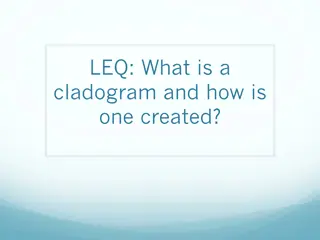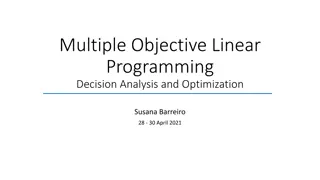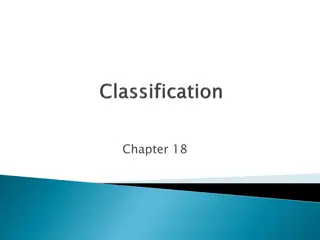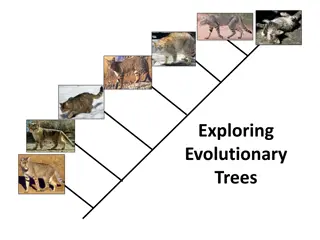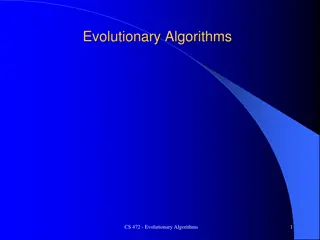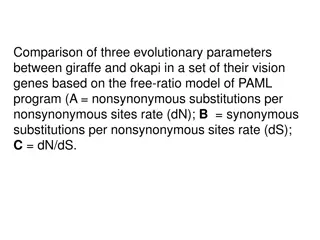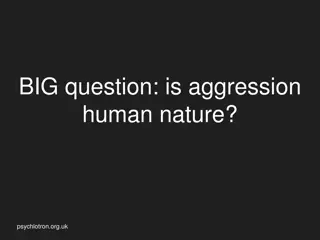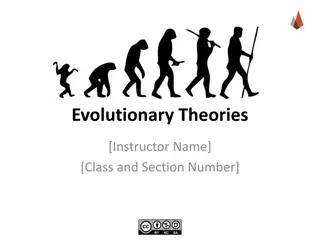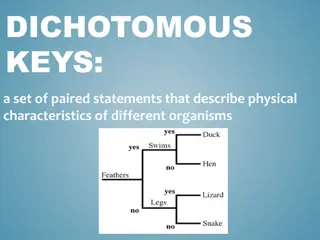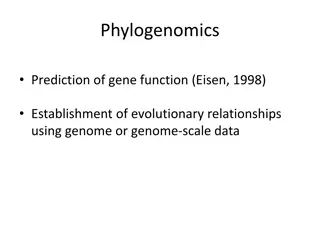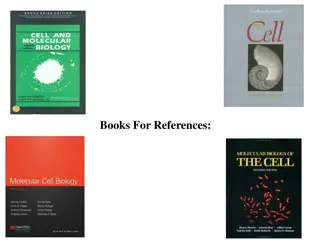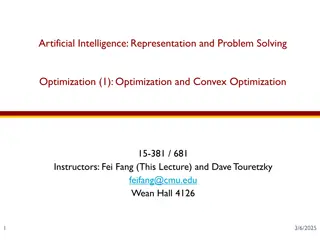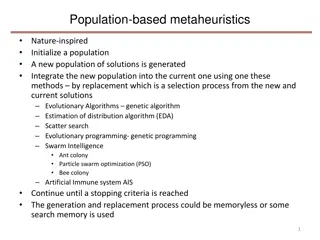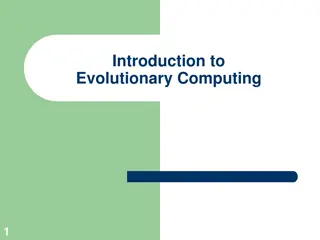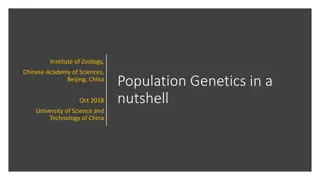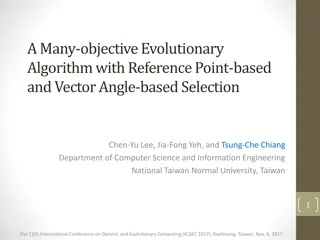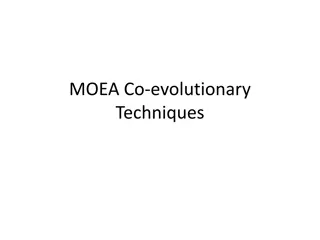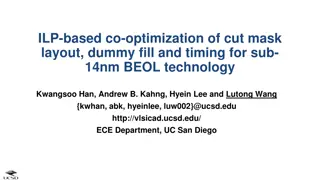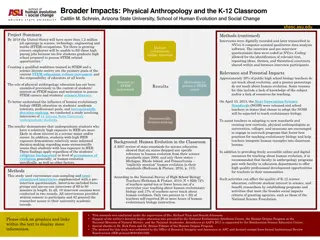Swarm Intelligence: Concepts and Applications
Swarm Intelligence (SI) is an artificial intelligence technique inspired by collective behavior in nature, where decentralized agents interact to achieve goals. Swarms are loosely structured groups of interacting agents that exhibit collective behavior. Examples include ant colonies, flocking birds,
4 views • 88 slides
Cladograms and Phylogenetic Analysis
Cladograms are used in cladistics to illustrate evolutionary relationships between organisms based on shared ancestral and derived characters. They are created by grouping species by common descent, forming clades that include an ancestral species and all its descendants. Valid clades are monophylet
0 views • 11 slides
DNN Inference Optimization Challenge Overview
The DNN Inference Optimization Challenge, organized by Liya Yuan from ZTE, focuses on optimizing deep neural network (DNN) models for efficient inference on-device, at the edge, and in the cloud. The challenge addresses the need for high accuracy while minimizing data center consumption and inferenc
1 views • 13 slides
Insights into Evolutionary Adaptation and Genetic Variation
The production order highlights the essential role of genomic variation as fuel for natural selection, driving evolutionary adaptation. The Cambrian Explosion timeframe reveals a rapid increase in evolutionary adaptation, showcasing the appearance of diverse animal phyla over a relatively short peri
8 views • 6 slides
Multiple Objective Linear Programming: Decision Analysis and Optimization
Explore the complexities of multiple objective linear programming, decision-making with multiple objectives, goal programming, and evolutionary multi-objective optimization. Discover the trade-offs and conflicts between various objectives in optimization problems.
7 views • 84 slides
Discrete Optimization in Mathematical Modeling
Discrete Optimization is a field of applied mathematics that uses techniques from combinatorics, graph theory, linear programming, and algorithms to solve optimization problems over discrete structures. This involves creating mathematical models, defining objective functions, decision variables, and
2 views • 12 slides
Generalization of Empirical Risk Minimization in Stochastic Convex Optimization by Vitaly Feldman
This study delves into the generalization of Empirical Risk Minimization (ERM) in stochastic convex optimization, focusing on minimizing true objective functions while considering generalization errors. It explores the application of ERM in machine learning and statistics, particularly in supervised
2 views • 11 slides
Computing Triplet and Quartet Distances Between Evolutionary Trees
Study on computing triplet and quartet distances in evolutionary trees, comparing rooted vs. unrooted, binary vs. arbitrary degree trees. Discusses algorithms, experimental results, and evolutionary tree construction methods. Includes analysis on cultural phylogenetics and evolutionary tree comparis
0 views • 27 slides
Insights into Recent Progress on Sampling Problems in Convex Optimization
Recent research highlights advancements in solving sampling problems in convex optimization, exemplified by works by Yin Tat Lee and Santosh Vempala. The complexity of convex problems, such as the Minimum Cost Flow Problem and Submodular Minimization, are being unraveled through innovative formulas
4 views • 47 slides
Taxonomy and Classification in Biology
Scientists use classification to group organisms logically, making it easier to study life's diversity. Taxonomy assigns universally accepted names to organisms using binomial nomenclature. Carolus Linnaeus developed this system, organizing organisms into species, genus, family, order, class, phylum
1 views • 11 slides
Evolutionary Pioneers: Anning, Darwin, Wallace - Key Figures in Evolutionary Theory
Meet the evolutionary pioneers - Mary Anning, Charles Darwin, and Alfred Russel Wallace, who played crucial roles in the development of evolutionary theory. Learn about their groundbreaking discoveries, challenges faced, and lasting impact on the scientific community.
0 views • 7 slides
Exploring Evolutionary Trees and Family Lineages
Dive into the world of evolutionary trees and family lineages through captivating visuals and informative illustrations. Explore the relationships between species, understand genetic connections, and discover how traits evolve and spread through generations. From evolutionary history to family trees
1 views • 25 slides
Approximation Algorithms for Stochastic Optimization: An Overview
This piece discusses approximation algorithms for stochastic optimization problems, focusing on modeling uncertainty in inputs, adapting to stochastic predictions, and exploring different optimization themes. It covers topics such as weakening the adversary in online stochastic optimization, two-sta
0 views • 33 slides
Evolutionary Algorithms in Computer Science
Evolutionary algorithms, particularly genetic algorithms, simulate natural evolution to optimize parameters and discover new solutions. By creating genomes representing potential solutions and using genetic operators like mutation and crossover, these algorithms populate a search space, conduct loca
0 views • 33 slides
Evolutionary Computation and Genetic Algorithms Overview
Explore the world of evolutionary computation and genetic algorithms through a presentation outlining the concepts of genetic algorithms, parallel genetic algorithms, genetic programming, evolution strategies, classifier systems, and evolution programming. Delve into scenarios in the forest where gi
0 views • 51 slides
Comparative Analysis of Evolutionary Parameters in Giraffe and Okapi Vision Genes
This presentation compares three evolutionary parameters (dN, dS, dN/dS) between giraffe and okapi in a set of vision genes using the free-ratio model of the PAML program. The images illustrate the differences in nonsynonymous and synonymous substitutions, as well as the ratio of nonsynonymous to sy
0 views • 4 slides
Aggression: Exploring Its Evolutionary Roots
Delve into the complexities of human aggression, questioning whether it is inherent or a learned behavior. Explore evolutionary theories and biological perspectives on the causes of aggression, examining how factors such as genetics, brain structures, hormones, and environmental pressures may influe
0 views • 11 slides
Evolutionary Theories and Strategies
Exploring evolutionary theories such as Sexual Selection Theory and Gene Selection Theory sheds light on how characteristics evolve for mating advantage. Insights into intersexual and intrasexual competition offer a deeper understanding of mate selection preferences. Gene selection mechanisms influe
1 views • 20 slides
Human Origins Through Hominid Fossils and Evolutionary Traits
Delve into the fascinating world of human origins, examining hominid fossils, anatomical traits, and evolutionary evidence. Learn about early species like Ardipithecus ramidus, differentiate African apes from modern humans, and analyze the genetic lineage supporting human evolution. Explore tables,
0 views • 14 slides
Dichotomous Keys and Cladograms in Evolutionary Biology
Dichotomous keys are utilized to classify different organisms based on their physical characteristics, while cladograms depict evolutionary relationships. Derived traits play a crucial role in understanding evolutionary history, indicating features present in later organisms but not earlier ones. Pr
0 views • 16 slides
Flower Pollination Algorithm: Nature-Inspired Optimization
Real-world design problems often require multi-objective optimization, and the Flower Pollination Algorithm (FPA) developed by Xin-She Yang in 2012 mimics the pollination process of flowering plants to efficiently solve such optimization tasks. FPA has shown promising results in extending to multi-o
2 views • 15 slides
Machine Learning Applications for EBIS Beam Intensity and RHIC Luminosity Maximization
This presentation discusses the application of machine learning for optimizing EBIS beam intensity and RHIC luminosity. It covers topics such as motivation, EBIS beam intensity optimization, luminosity optimization, and outlines the plan and summary of the project. Collaborators from MSU, LBNL, and
3 views • 23 slides
Phylogenomics and Gene Function Prediction in Evolutionary Biology
Explore the significance of phylogenomics in predicting gene functions and establishing evolutionary relationships using genome-scale data. Learn about the challenges of using single genes or a few genes in phylogenetic analysis, the importance of analyzing multilocus data, and the need for multiple
0 views • 24 slides
Fast Bayesian Optimization for Machine Learning Hyperparameters on Large Datasets
Fast Bayesian Optimization optimizes hyperparameters for machine learning on large datasets efficiently. It involves black-box optimization using Gaussian Processes and acquisition functions. Regular Bayesian Optimization faces challenges with large datasets, but FABOLAS introduces an innovative app
0 views • 12 slides
Cell Organization and Evolutionary Perspectives
Prokaryotic and eukaryotic cells are the basic units of all living matter. This article explores the differences in organization between these two cell types, their characteristics, and evolutionary relationships. From discussing cellular structures to the presence of endomembranes, mitochondria, an
0 views • 66 slides
Methods of illustrating evolutionary relationship
Systematics involves grouping and determining the relationships among organisms through Taxonomy and Phylogenetics. Taxonomy focuses on classifying and naming organisms, while Phylogenetics studies evolutionary relationships. Evolutionary trees, sister taxa, clades, monophyletic and paraphyletic gro
0 views • 6 slides
Machine learning optimization
Dive into the world of machine learning optimization with a focus on gradient descent, mathematical programming, and constrained optimization. Explore how to minimize functions using gradient descent and Lagrange multipliers, as well as the motivation behind direct optimization methods. Discover the
0 views • 16 slides
Artificial Intelligence: Representation and Problem Solving Optimization
This lecture explores optimization and convex optimization in the field of Artificial Intelligence, covering topics such as defining optimization problems, discrete and continuous variables, feasibility, and different types of optimization objectives. The content delves into the challenges and solut
0 views • 36 slides
Nature-Inspired Population-Based Metaheuristics and Optimization Techniques
This comprehensive guide delves into various population-based metaheuristics and nature-inspired optimization techniques such as evolutionary algorithms, swarm intelligence, and artificial immune systems. It covers concepts like genetic algorithms, ant colony optimization, particle swarm optimizatio
0 views • 6 slides
Introduction to Evolutionary Computing - Key Components and Applications
Dive into the world of Evolutionary Computing with this comprehensive overview by A.E. Eiben and J.E. Smith. Learn about the key components of an EC system, the evolutionary cycle, and the various views and applications of Evolutionary Computing. Explore how this field applies biological evolution t
0 views • 30 slides
Understanding Discrete Optimization in Graph Theory
Explore the relationship between counting techniques, graph theory, and discrete optimization, with examples illustrating the transition from counting problems to optimization problems. Learn about applying optimization in scheduling and making graph models, as well as the role of graphs in discrete
1 views • 8 slides
Understanding Evolutionary Psychology in Education: Applied Examples
Explore the practical applications of evolutionary psychology in education through examples like adaptation, altricial species, evolutionary mismatch, and reciprocal altruism. Understand how these concepts can enhance educational outcomes and student interaction.
0 views • 20 slides
Understanding Evolutionary Algorithms and Their Applications
Discover the concept of Evolutionary Algorithms (EAs) through the insightful discussion by A.E. Eiben and J.E. Smith with additional modifications by Ch. Eick. Explore the fundamental components, behaviors, and potential applications of EAs in optimization processes.
1 views • 39 slides
Evolutionary Insights: Population Genetics Overview and Historical Context
Explore the foundational concepts of population genetics, including Hardy-Weinberg Equilibrium, natural selection, genetic drift, and more. Delve into the historical context of evolutionary theory from Darwin to modern research, highlighting the significance of quantitative approaches in evolutionar
0 views • 45 slides
Many-Objective Evolutionary Algorithm with Reference Point-Based Selection
Explore a many-objective evolutionary algorithm with reference point-based and vector angle-based selection presented at the 11th International Conference on Genetic and Evolutionary Computing. Dive into the introduction, proposed algorithm, experiments, and conclusions of this innovative approach t
0 views • 16 slides
Understanding Coevolutionary Techniques in Evolutionary Computation
Explore the concept of coevolution in evolutionary computation, where species interact and evolve together, influencing each other's genetic composition. Learn about competitive and cooperative coevolutionary algorithms and their roles in enhancing evolutionary techniques.
0 views • 13 slides
Cut Mask Co-Optimization for Advanced BEOL Technology
Explore the ILP-based co-optimization of cut mask layout, dummy fill, and timing for sub-14nm BEOL technology. The proposed approach addresses self-aligned multiple patterning, cut process extension, and the impact of cut mask optimization on wire performance. Learn about related works, motivation,
0 views • 23 slides
Enhancing STEM Education Through Human Evolutionary Biology Exposure
Explore how human evolutionary biology education impacts students' interest in STEM majors and careers. Learn about the importance of integrating evolutionary biology into K-12 science education to foster a science-literate society. Discover the findings from a study involving Arizona State Universi
0 views • 15 slides
Optimization Fundamentals and Applications
Explore the essentials of optimization with this PowerPoint presentation by Peggy Batchelor from Furman University. Learn how to recognize decision-making scenarios suitable for optimization modeling, formulate algebraic and spreadsheet models for linear programming problems, and use Excel's Solver
0 views • 33 slides
Evolutionary Fitness in Design Science: Enhancing Creativity and Outcomes
Explore the integration of evolutionary fitness principles into design science, focusing on enhancing creativity, refining outcomes, and understanding the real-world impact of design artifacts. Dive into the concepts of fitness in design, the application of evolutionary principles, and how they shap
0 views • 14 slides

